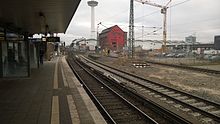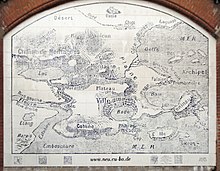Hamburg Sternschanze station
| Hamburg Sternschanze | |
|---|---|
 Station with the modernized facade of
the reception building from 1903 |
|
| Data | |
| Platform tracks | 2 |
| abbreviation | ASTZ (train station) ASST (S-Bahn) |
| IBNR | 8070146 |
| Price range | 3 |
| Profile on Bahnhof.de | Sternschanze |
| location | |
| Place / district | Sternschanze |
| country | Hamburg |
| Country | Germany |
| Coordinates | 53 ° 33 '50 " N , 9 ° 58' 2" E |
| Railway lines | |
| Railway stations in the Hamburg area | |
The sternschanze station is part of the Hamburg-Altona link line . It was built in 1903 between the Holstenstrasse and Dammtor train stations . It was named at the time of the former there contained advanced defense work of Hamburg ramparts , the Sternschanze whose name also, in 2008 by the newly created administrative and train stations inclusive Sternschanze district received.
Originally set up for passenger traffic including long-distance trains and for freight traffic , since the end of car train loading in 1996, only the S-Bahn platform has been used by the S11, S21 and S31 S-Bahn lines . From the eastern end of the platform there is a transition via stairs and a connecting corridor to the section of the U3 underground line that crosses here and runs in the tunnel with the Sternschanze stop of the same name.
First train station from 1866
The building of the original Sternschanze station of the Hamburg-Altona connecting railway from 1866 is still preserved. It is located about 400 meters east of today's reception building, directly north of the S-Bahn tracks on Sternschanze 1 street . The station was equipped with the usual waiting and luggage rooms and ticket issuance, a platform at the house and a central platform. After the completion of the new passenger station in 1903, the station building, built in the late Classicist style between 1864 and 1866, was used for administrative and residential purposes and has been a listed building since 1989 .
Freight depot

In addition to the passenger station, there were initially freight tracks in the southern area, which have now been dismantled. They served u. a. the connection of the slaughterhouse and the Zollverein defeat , a large warehouse complex that served as a branch for the Hamburg free port . A siding also led across the slaughterhouse to the Karoline power station and the Budapester Strasse freight yard on the edge of the Heiligengeistfeld , a. served as a loading point for the showmen of the Hamburg Cathedral .
Since the 1970s, another track has led from Sternschanze station under Rentzelstrasse bridge to a platform in the Tiergartenstrasse area . Here u. a. Exhibition trains ( CCH ), this track also served as a pull-out track for the shunting traffic of the car loading station , which was set up here during the new construction of the Hamburg-Altona station in 1979 .
Railway station from 1903
In connection with the re-routing of the Hamburg-Altona connection line, a direct connection between the underground station planned for 1912 at Sternschanze and the connection line station was planned. For this project, the Sternschanze station of the connecting railway was rebuilt 400 meters further west, whereby "... today's underground tunnel was also built during its construction in 1901".
The new station was built on an elevated embankment as part of the reorganization of Hamburg's railway systems at the beginning of the 20th century and opened on May 15, 1903. It had two tracks each for the former Hamburg-Altona light rail and suburban railway and for the long-distance railway with intermediate platforms in between, since the Dammtor, Sternschanze and Holstenstraße stations were originally also stops for long-distance traffic based on the model of the Berlin light rail . A vaulted steel girder hall with glass inserts similar to the Hamburg-Dammtor train station spanned all four tracks. The tracks of the now higher station cross Schanzenstrasse at the west end . The main entrance is also located there.
The preliminary design for the station building facing Schanzenstrasse was made by the chief building officer Caesar, the government building officer Schwartz and the railway building inspector Ernst Moeller at the Altona Royal Railway Directorate . Caesar and Schwartz had also designed the Dammtor station . The construction costs for the Sternschanze station were 237,000 marks for the station building, 248,000 marks for the platforms and platform hall, 75,000 marks for the underpass of Schanzenstrasse, a total of 560,000 marks (at today's prices this is around 3,795,912 euros).
Condition since the 1970s
The roof of the hall, which remained largely undamaged during the Second World War, was torn down in early 1975. The Deutsche Bundesbahn justified the step back then by stating that the ongoing maintenance of a simple platform roof was much cheaper than the maintenance of the steel / glass hall from 1903. In addition, the preservation of an “Art Nouveau station” [Dammtor station] was completely sufficient. The long-distance platform was also removed except for marginal remains at the eastern end. The platform of the S-Bahn , which has now been known as this since 1934, was covered over its entire length by a newly laid flat roof.
Since 2008, the futuristic building of the Hamburg-Schwerin branch of the Federal Railway Authority has been erected on stilts close to the southern long-distance railway track opposite the S-Bahn platform .
In 2015, an additional exit to the south side was created at the east end of the station, with the extension of the connecting corridor to the underground station, under the embankment, in order to better connect the exhibition center , which was expanded and modernized in 2009 . The 60 meter long underpass can also be used by cyclists. The cost of the project is 11.6 million euros.
The station is now only a stop for local transport in the Hamburg transport association and is served by the S-Bahn lines S21 and S31, and also by the S11 during main traffic times. S-Bahn trains can regularly end and start again in Sternschanze, to the west of the platform there is a turning system designed as a stump track .
At the western end of the station, a tile mosaic with an imaginatively designed fictional map by the artist Sabine Mohr was inserted in the arched wall niche below the bridge over Schanzenstrasse.
Sternschanze as a tariff limit
Since 1967, no long-distance train has had a stop at Sternschanze station, yet it was the starting or end point for the tariff distances between Hamburg and the other German long-distance train stations. These were calculated to and from Hamburg-Sternschanze and entitle them to travel to and from all train stations between Hamburg-Hauptbahnhof and Hamburg-Altona, including the City-S-Bahn, although the line ran over Jungfernstieg, Landungsbrücken and Reeperbahn and the train station Sternschanze did not touch.
U-Bahn station of the elevated railway
At the eastern end of Sternschanze station, the U3 line of the Hamburg subway crosses in a north-south direction . The station, for which the underground tunnel system was built during the construction of the connecting railway station, is part of the Hamburg Hochbahn ring line, opened in 1912, and has the operating abbreviation SZ. Around 24,000 passengers use the subway here every day (Mon – Fri, 2017). The central platform is located north of the connecting line in the tunnel and has only one exit at the southern end to the Sternschanze street and the S-Bahn platform. Right from the start there was an option to switch to the railway and the former urban and suburban railway or today's S-Bahn. The stairs to the platform are quite narrow, angular and small, so that no escalator could be inserted here. Up until 2015, there was a small side room here, which was used one after the other for a snack bar and baked goods sales, and was then dismantled when the underpass to the exhibition center was built. A special feature of this underground subway station is a skylight at the southern end of the platform, which allows some daylight to reach the platform.
Another peculiarity was that due to the aforementioned structural confinement, S-Bahn tickets were also sold by the Hochbahn staff years before the Hamburg Transport Association was established with its joint tariff in the underground ticket office. In addition to the elevated railway ticket printer, the counter was also equipped with a Federal Railway printer .
Regional and rapid transit lines
The S11 line only operates during rush hour . The A1 also drives to the station twice a day:
Web links
Individual evidence
- ↑ Station category overview DB 2015 (PDF; 361 kB)
- ↑ a b The history of the Hamburger Hochbahn / The years 1891 - 1912 Section "1899" ( Memento from March 10, 2012 in the Internet Archive )
- ↑ a b Hamburg's subway stations: The ring line ( Memento from September 24, 2015 in the Internet Archive )
- ↑ a b The history of the Hamburger Hochbahn / The years 1891 - 1912 Section “1901 First preliminary construction work for the small railway” and Section “1903” ( Memento from March 10, 2012 in the Internet Archive )
- ↑ Erich Staisch: Hamburg and the railroad . Zimmer-Verlag, Eppstein iT 1969
- ^ Rüdell : The new station building in Hamburg: The station building at the Sternschanze station . In: Zentralblatt der Bauverwaltung , Vol. XXIV, No. 66 (August 17, 1904), urn : nbn: de: kobv: 109-opus-37788 , pp. 414–416 (five images)
- ↑ New pedestrian tunnel opened at Sternschanze. In: Hamburger Abendblatt , accessed on December 8, 2015
- ^ Uwe-Jens Jansen: The railway in Hamburg . Carlsen-Verlag, Hamburg 1999
- ↑ Answer of the Hamburger Hochbahn of December 17, 2018 to an inquiry about the Hamburg Transparency Act. In: fragdenstaat.de, accessed on February 2, 2019.







